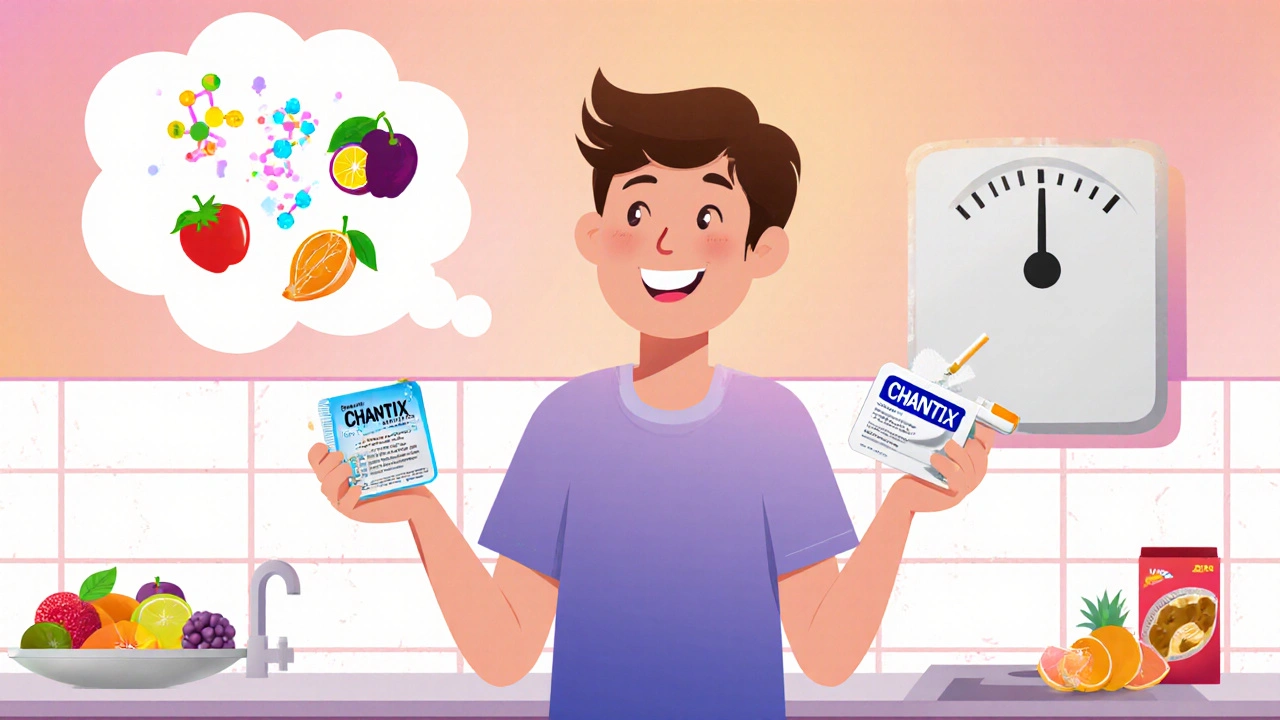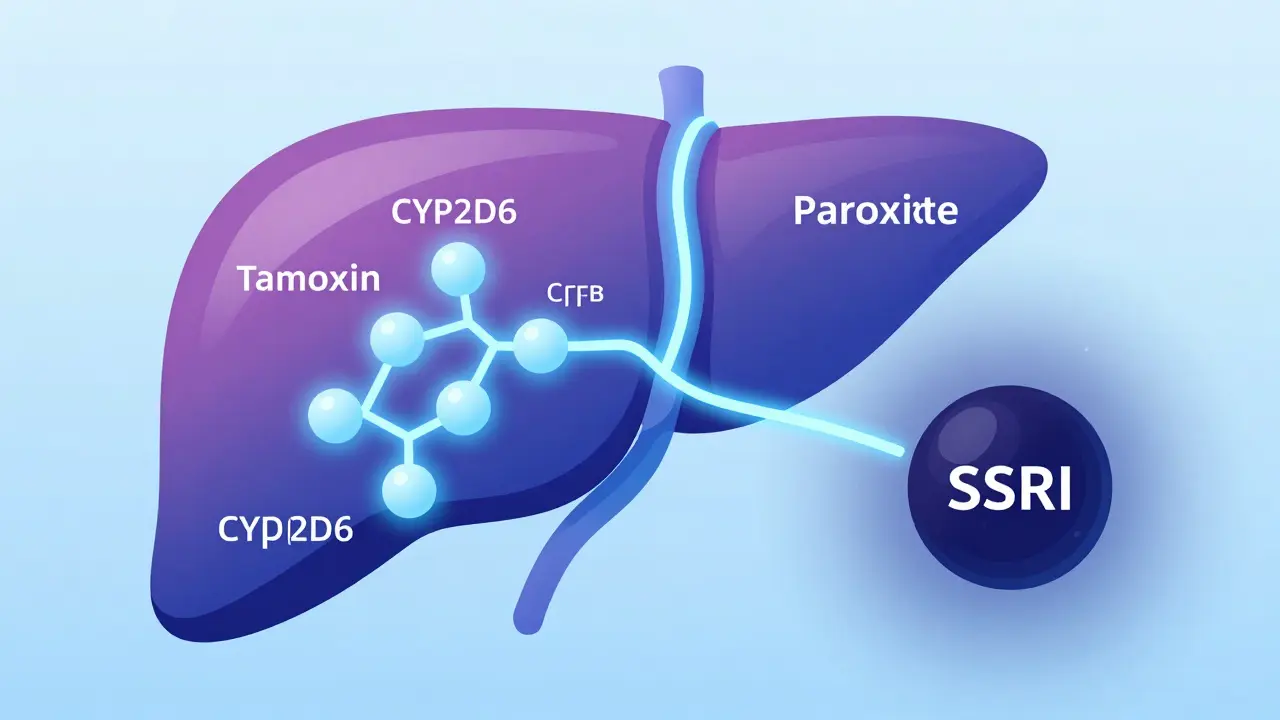Varenicline Weight Management Calculator
Personal Information
Results
Ever notice that the moment you quit smoking, the scale starts ticking up? You’re not alone-many people experience weight changes when they stop nicotine. The good news is that with the right plan you can keep the extra pounds at bay while still enjoying the cravings‑crushing power of varenicline.
What triggers weight gain after quitting?
When you breathe in nicotine, it acts like a tiny metabolic rev‑up button. Removing that stimulus slows your basal metabolic rate by roughly 3‑5%, meaning you burn fewer calories at rest. At the same time, nicotine dulls taste buds and suppresses appetite, so you often eat more once it’s gone. Add a touch of stress from withdrawal, and the body tends to stash the extra calories as fat.
Varenicline is a partial agonist at the nicotinic acetylcholine receptor - how does that affect weight?
Varenicline (brand name Chantix) binds to the same receptors nicotine targets, delivering a milder stimulation that eases cravings. Because it still activates those receptors, many users report less of the classic nicotine‑withdrawal appetite surge. However, the drug’s mood‑boosting effect can also restore the pleasure of eating, especially sugary snacks, leading to a modest weight gain of 1‑2 kg for most people.
Key factors that shape your post‑quit weight
- Nicotine withdrawal reduces thermogenesis, the body’s heat‑producing calorie burn.
- Appetite often rebounds as cravings shift to food.
- Metabolism slows slightly, especially in the first few weeks.
- Psychological stress can trigger emotional eating.
- Changes in daily routine - you may replace smoking breaks with snack breaks.
Practical steps to keep the pounds off
- Track what you eat. A simple phone app showing calories and macronutrients makes hidden snacking visible.
- Prioritise protein at every meal. Protein increases satiety and supports muscle mass, which keeps metabolism humming.
- Stay hydrated. Thirst is often mistaken for hunger; aim for 2‑3 L of water daily.
- Plan snack portions. Choose high‑fiber options (e.g., carrots, apple slices with a dab of peanut butter) and pre‑measure them.
- Schedule regular activity. Even a brisk 20‑minute walk after meals blunts the insulin spike that drives fat storage.

Nutrition tricks that work while on varenicline
Because varenicline can make sweet foods taste richer, use that to your advantage. Replace candy with fresh fruit, which offers natural sugars plus fiber that slows absorption. Adding a spoonful of chia seeds or ground flaxseed to yogurt or oatmeal boosts omega‑3s and keeps you fuller longer.
Watch out for “cheat meals.” If you allow yourself an unrestricted binge once a week, you may undo several days of good choices. Instead, enjoy a favourite dish in a measured portion and pair it with a side of greens.
Exercise routines that fit the quitting journey
Exercise does three things for a new‑quitter: it burns extra calories, lifts mood (helping with withdrawal), and restores muscle mass lost from the slight metabolic dip. Here’s a simple weekly plan you can start with:
- Monday & Thursday - Cardio: 30 minutes of moderate‑intensity activity such as cycling, jogging, or a fast‑paced walk.
- Tuesday - Strength: Full‑body circuit (body‑weight squats, push‑ups, lunges, plank) - 3 rounds of 12 reps each.
- Wednesday - Flexibility: 20‑minute yoga or stretching session to ease stress.
- Friday - Mixed: 15 minutes HIIT (high‑intensity interval training) followed by 15 minutes of light walking.
- Weekend - Light activity: Choose something you enjoy - gardening, swimming, or a hike.
Consistency beats intensity. Even 10‑minute bouts accumulate and protect against weight gain.
When to involve your health professional
If you notice rapid weight gain (>5 kg in a month), persistent cravings for high‑calorie foods, or mood swings that interfere with daily life, it’s time to talk to your doctor or pharmacist. They can adjust the varenicline dose, suggest an adjunct therapy like bupropion, or refer you to a dietitian. In Australia, the Therapeutic Goods Administration (TGA) monitors varenicline’s safety profile, so any emerging side‑effects should be reported.
Quick reference table: Weight‑management strategies while using varenicline
| Strategy | Calorie control | Ease of start | Effectiveness during quit | Typical time to see results |
|---|---|---|---|---|
| High‑protein, high‑fiber diet | High | Medium | Very effective | 1‑2 weeks |
| Structured exercise (cardio + strength) | Medium | Medium | Effective | 2‑4 weeks |
| Behavioral therapy / mindfulness | Low | Low | Effective for emotional eating | 3‑6 weeks |
| Adjunct medication (e.g., bupropion) | Varies | Low (prescription needed) | Can reduce cravings for food | 4‑8 weeks |
Common pitfalls and how to avoid them
Pitfall 1: Treating nicotine cravings as hunger. Take a deep‑breath pause first. If the urge fades, you likely weren’t really hungry.
Pitfall 2: Skipping meals. Skipping fuels binge later. Aim for three balanced meals plus a scheduled snack.
Pitfall 3: Over‑reliance on “low‑fat” foods. Many low‑fat products add sugar, sabotaging weight control. Read labels.
Pitfall 4: Ignoring sleep. Sleep deprivation spikes ghrelin, the hunger hormone, making weight gain more likely. Target 7‑8 hours/night.
Bottom line
Varenicline gives you a powerful edge against nicotine, but it doesn’t guarantee a flat waist. By pairing the medication with mindful eating, regular movement, and a dash of professional support, you can quit smoking and stay on target with your weight goals. Remember: the scale is just one piece of the health puzzle - the biggest win is the clean lungs and longer life ahead.
Can varenicline cause weight loss instead of gain?
In a minority of users, varenicline’s appetite‑suppressing effect outweighs the metabolic slowdown, leading to modest weight loss. This is more common in people who already follow a calorie‑controlled diet.
How long does the weight‑gain phase usually last?
Most people see the biggest jump in the first 4‑6 weeks after quitting. After that, metabolism stabilises and weight‑gain plateaus if you maintain healthy habits.
Should I stop varenicline if I’m gaining weight?
No. Stopping the medication can trigger a nicotine relapse, which poses a far greater health risk. Instead, adjust diet and activity, or discuss adding a complementary therapy with your doctor.
Is it safe to combine varenicline with a weight‑loss supplement?
Most supplements have not been studied with varenicline, and some may interfere with its metabolism. Always check with a pharmacist or your GP before adding anything.
What role does the Australian TGA play in monitoring varenicline?
The Therapeutic Goods Administration evaluates safety reports, updates prescribing information, and issues alerts if new side‑effects (including unexpected weight changes) emerge.







Jinny Shin
October 23, 2025 AT 12:54While the pharmacological allure of varenicline captivates the earnest quitter, one must not neglect the subtle choreography of metabolism that follows the nicotine exodus. The literary art of balancing macronutrients becomes a refined performance, and the mere suggestion of a trivial snack can feel like a melodramatic interlude. Thus, a measured approach, akin to a well‑directed stage play, ensures the curtain falls on unwanted pounds.
deepak tanwar
October 25, 2025 AT 20:28It would be unwise to accept the premise that varenicline alone mitigates appetite resurgence; the literature indicates a heterogeneous response among populations. Moreover, the suggestion that protein intake alone stabilises basal metabolic rate oversimplifies a multifactorial physiological adaptation. One should therefore scrutinise the cited studies before adopting a one‑size‑fits‑all protocol.
Vikas Kumar
October 28, 2025 AT 03:01From an Indian perspective, the traditional emphasis on spices and whole grains can naturally counteract the modest weight gain described. Cumin, fenugreek, and turmeric not only invigorate metabolism but also satiate cravings that often replace nicotine. Embracing these heritage foods aligns with cultural resilience while navigating pharmacotherapy.
Celeste Flynn
October 30, 2025 AT 10:34When you begin a varenicline regimen, the first step is to establish a clear record of your daily intake. Many smartphone apps allow you to log calories, macronutrients and even beverage water consumption. Seeing the numbers in front of you often reveals hidden snacking patterns that you might otherwise ignore. Aim to incorporate a source of lean protein into each meal, because protein promotes satiety and helps preserve lean muscle mass during the metabolic dip. Examples include eggs, low‑fat Greek yogurt, legumes, or a modest portion of poultry or fish. If you find yourself reaching for sweets, substitute fresh fruit, which provides natural sugars along with fiber that slows glucose absorption. Adding a tablespoon of chia seeds or ground flaxseed to your oatmeal can boost omega‑3 intake and increase fullness. Hydration is another often‑overlooked factor; thirst can masquerade as hunger, so aim for at least two to three liters of water daily. Plan your snacks ahead of time, measuring portions into reusable containers to avoid mindless overeating. High‑fiber options such as carrot sticks, celery, or apple slices with a thin spread of nut butter are excellent choices. Beyond diet, schedule light to moderate physical activity each day; a brisk 20‑minute walk after meals can blunt the insulin spike that encourages fat storage. Strength training two to three times per week supports muscle maintenance, which in turn sustains a higher resting metabolic rate. Flexibility work, like yoga or gentle stretching, can alleviate stress and reduce emotional eating triggers. If you notice a sudden or rapid weight gain-more than five kilograms within a month-consult your healthcare provider promptly. They may adjust your varenicline dosage, add a complementary medication, or refer you to a dietitian for personalized guidance. In practice, combining these nutritional strategies with consistent movement typically yields a stable weight profile within the first six weeks of quitting.
Shan Reddy
November 1, 2025 AT 18:08Got a quick tip: swap out the usual soda for sparkling water with a splash of citrus. The fizz tricks your brain into thinking you’re indulging, while the zero calories keep the scale honest. Just a tiny change that adds up over weeks.
Peter Richmond
November 4, 2025 AT 01:41Indeed, the substitution of calorie‑free carbonated beverages can attenuate the hedonic drive associated with sugary drinks. Research supports that even modest reductions in liquid calories contribute to weight maintenance during nicotine cessation.
hema khatri
November 6, 2025 AT 09:14Friends, let’s not forget that our great nation’s diet is a treasure trove of flavor and health!!
Spice‑laden curries, lentil soups, and wholesome flatbreads can fire up metabolism like a patriotic fireworks display!!!
When using varenicline, pair it with these traditional meals, and you’ll see the pounds stay in check, I promise!!!
Jennell Vandermolen
November 8, 2025 AT 16:48Consider pairing the suggested traditional dishes with portion‑controlled servings to avoid accidental over‑eating.
A simple visual cue, such as a plate divided into thirds, can help keep carb, protein, and veg portions balanced.
Staying mindful of these guidelines will reinforce the benefits you’re already gaining from the medication.
Mike Peuerböck
November 11, 2025 AT 00:21From a culinary perspective, the symphony of flavors encountered during a quit journey can be orchestrated to support metabolic equilibrium.
Integrating vibrant vegetables, lean proteins, and wholesome grains creates a palate that satisfies without excess caloric indulgence.
Such gastronomic strategy, when aligned with varenicline’s modest appetite modulation, can mitigate the typical post‑cessation weight plateau.
Remember, the goal is sustainable health, not a fleeting diet.
Simon Waters
November 13, 2025 AT 07:54The real reason weight spikes is hidden industry additives, not the drug itself.
CASEY PERRY
November 15, 2025 AT 15:28Implementing a macros‑centric framework leverages thermogenic pathways, thereby optimizing energy expenditure during nicotine withdrawal.
Quantitative tracking facilitates evidence‑based adjustments, ensuring compliance with the pharmacodynamic profile of varenicline.
This approach aligns with clinical best practices.
Naomi Shimberg
November 17, 2025 AT 23:01While the critique of varenicline’s singular efficacy is noted, one must also consider the psychosocial variables that confound isolated metabolic assessments.
Neglecting factors such as socioeconomic status, stress levels, and cultural dietary patterns renders any blanket dismissal scientifically untenable.
Consequently, an integrative perspective, rather than a reductionist dismissal, better serves the clinical discourse.